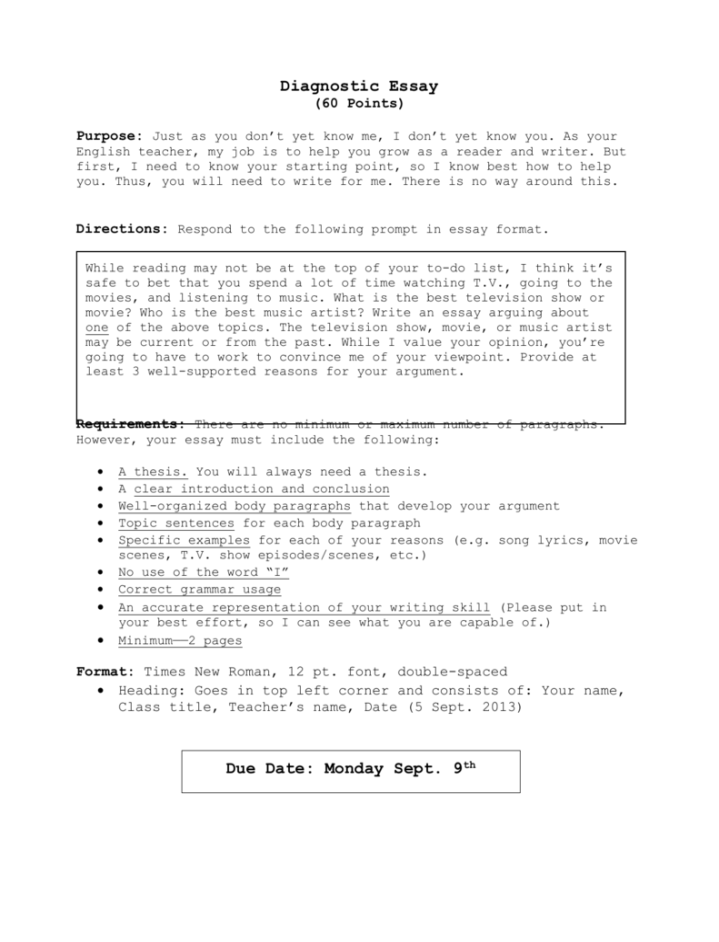Diagnostic Essay Format: A Comprehensive Guide
What do you mean by a Diagnostic Essay?

A diagnostic essay is an essential tool used by educators to assess a student’s writing abilities and identify areas that need improvement. It is usually assigned at the beginning of a course or semester to help instructors understand the strengths and weaknesses of their students’ writing skills. This type of essay is not graded; instead, it serves as a diagnostic tool to guide educators in tailoring their teaching methods to suit their students’ needs.
How to Approach a Diagnostic Essay?

When faced with a diagnostic essay prompt, it is crucial to understand the specific instructions and requirements. Here are a few steps to help you approach your diagnostic essay:
1. Analyze the Prompt: Carefully read the prompt and identify the key points, understanding what is expected of you.

2. Plan your Response: Create an outline to organize your thoughts and arguments. This will help you maintain coherence throughout your essay.
3. Introduction: Begin your essay with an engaging opening sentence that introduces the topic and provides context.
4. Body Paragraphs: Develop your ideas in separate paragraphs, each focusing on a specific aspect related to the prompt. Support your points with evidence and examples.
5. Conclusion: Summarize your main points and provide a conclusive statement to wrap up your essay.
6. Revise and Edit: After completing your essay, take the time to revise and edit it for clarity, coherence, grammar, and punctuation errors.
What is known about the Diagnostic Essay Format?
The diagnostic essay format is typically flexible, allowing students to showcase their writing skills in various forms such as descriptive, narrative, or argumentative essays. However, certain common elements should be considered while adhering to the general essay structure:
1. Introduction: Begin with an attention-grabbing opening statement or a relevant anecdote that sets the tone for your essay. Clearly state your thesis or the main argument of your essay.
2. Body Paragraphs: Elaborate on your thesis statement by presenting supporting evidence and examples. Each paragraph should focus on one main idea and seamlessly transition to the next.
3. Transitions: Use transitional words and phrases to ensure a smooth flow between ideas and paragraphs.
4. Conclusion: Summarize your main points and restate your thesis in a concise manner. Leave the reader with a thought-provoking or memorable closing statement.
Solution: How to Write an Effective Diagnostic Essay?
Writing a successful diagnostic essay requires a systematic approach and attention to detail. Here are some tips to help you write an effective diagnostic essay:
1. Follow the Instructions: Ensure that you understand the prompt and adhere to the given guidelines.
2. Focus on Structure: Organize your essay in a clear and logical manner, with a strong introduction, well-developed body paragraphs, and a concise conclusion.
3. Provide Evidence: Support your arguments with relevant evidence, examples, and citations where appropriate.
4. Use Proper Grammar and Vocabulary: Pay attention to grammar, spelling, and punctuation. Use appropriate vocabulary and sentence structures to convey your ideas effectively.
5. Revise and Edit: Take the time to review and edit your essay for coherence, clarity, and overall effectiveness. Eliminate any errors or inconsistencies.
Additional Information about Diagnostic Essays
1. Time Limit: Diagnostic essays are usually timed, so manage your time effectively to complete the essay within the given constraints.
2. Purpose: Diagnostic essays help educators identify the specific areas where students need improvement, allowing for targeted instruction and support.
3. Feedback: Although diagnostic essays are not graded, instructors may provide feedback on areas that require improvement and offer suggestions for enhancement.
4. Skill Enhancement: Through diagnostic essays, students can gain insights into their writing strengths and weaknesses, enabling them to focus on areas that need improvement throughout their academic journey.
Conclusion
Diagnostic essays are valuable tools that aid in understanding students’ writing capabilities. By following the recommended format and guidelines, students can effectively showcase their skills while educators can tailor their teaching methods accordingly. These essays not only help identify areas of improvement but also serve as a foundation for honing writing skills throughout an individual’s academic journey.
Frequently Asked Questions (FAQs)
Q1: Can I use personal anecdotes in my diagnostic essay?
A1: Yes, incorporating personal anecdotes can add depth and authenticity to your essay, making it more engaging for the reader.
Q2: How long should a diagnostic essay be?
A2: The length of a diagnostic essay may vary depending on the instructions provided. However, it is generally recommended to aim for around 500-800 words.
Q3: Can I use outside sources in my diagnostic essay?
A3: It is best to check the prompt or consult with your instructor to determine whether outside sources are allowed. In most cases, diagnostic essays are based on personal experiences and opinions.
Q4: Are diagnostic essays graded?
A4: Diagnostic essays are primarily used for assessment purposes and are not typically assigned a grade. However, instructors may provide feedback and suggestions for improvement.
Q5: Can I revise my diagnostic essay after submitting it?
A5: While diagnostic essays are meant for diagnostic purposes and not final assessment, it is generally not possible to revise or submit changes once it has been handed in.